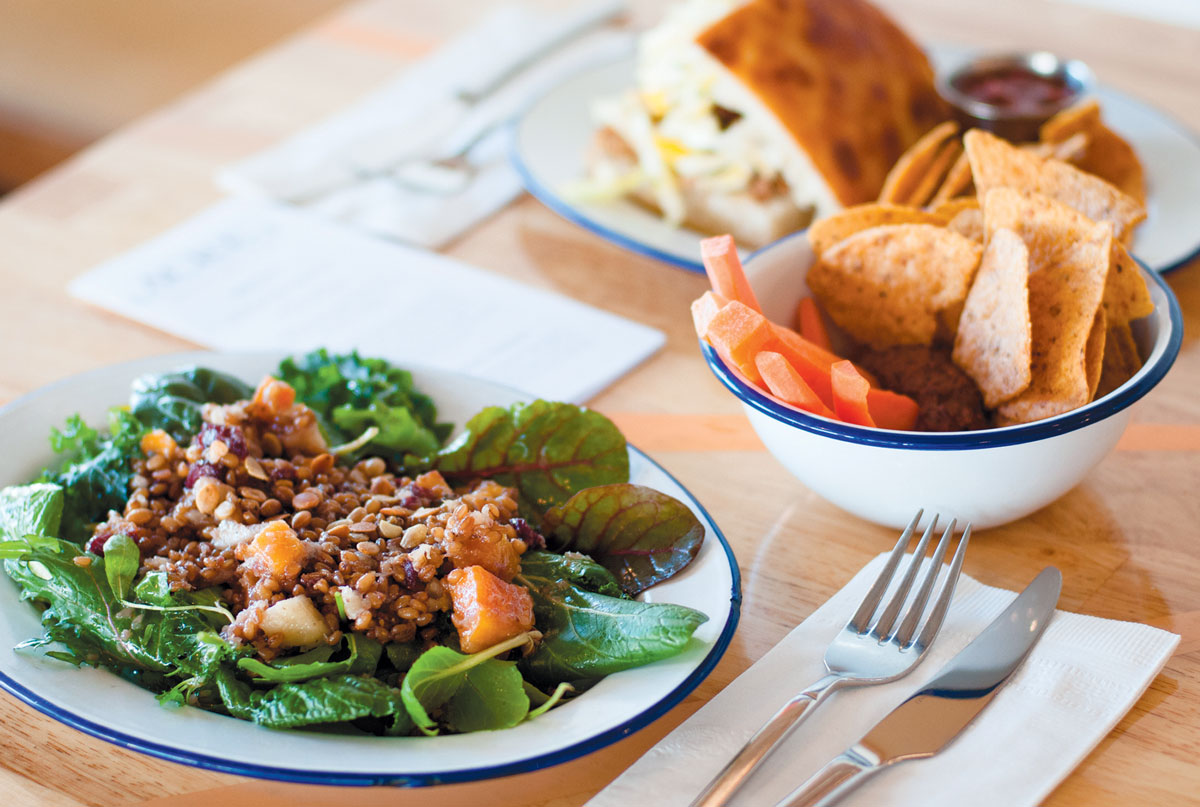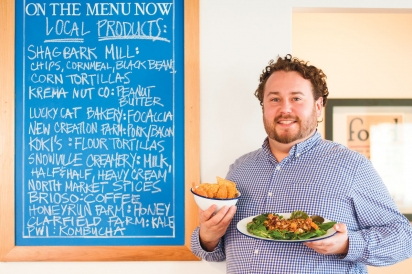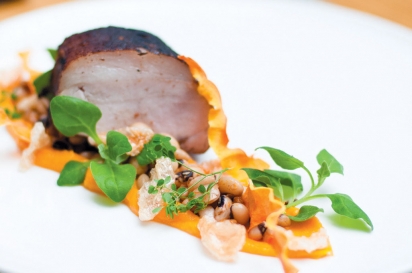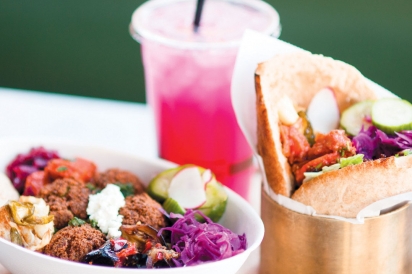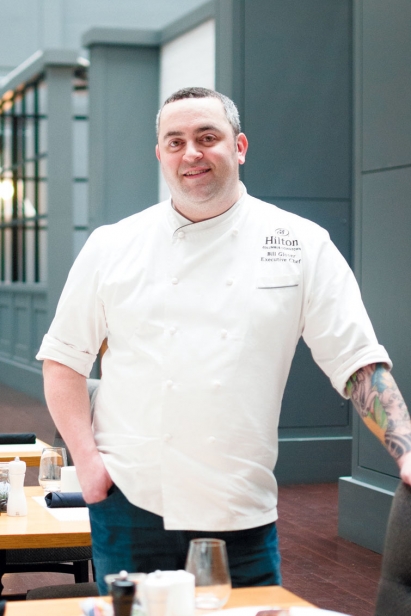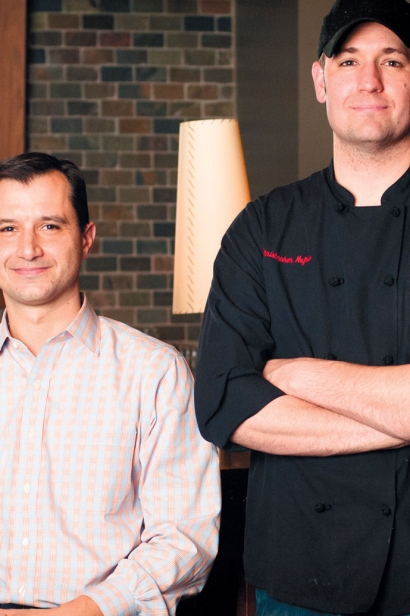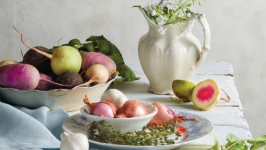Home Plate
What it takes for Columbus restaurants to bring true farm-to-table ingredients to you
On a recent evening dining out, Bryn Bird, whose family owns Bird’s Haven Farms in Granville, noticed her family’s farm listed as a supplier in beautifully crafted cursive writing on a chalkboard hanging prominently in the restaurant.
“I thought, ‘that’s funny, we haven’t sold anything to them in nearly a year’,” says Bryn.
“Local”‘ is a word that you can find splashed on menus across town. Consumers and those in the food industry happily welcome the movement for fresh foods that grow regional economies. Yet as Bryn can attest, the buzzword has also met exploitation in the name of marketing. And while farms face increased public transparency to disclose their growing methods, restaurants often face zero accountability in their farm-to-table advertising.
Commitment to a Core Philosophy
“We don’t really know any other way to run our business,” says Todd Mills, owner of Acre Restaurant, which opened in 2014 and is located in the Old North neighborhood of Columbus.
“From the beginning, the point of opening this restaurant was to help build the local food economy and provide an outlet for locally-grown products.”
Todd and his chef, Paul Millman, estimate that during the peak of the growing season most of their products are sourced from area producers. In the off-season, staples like tortillas, bread, beans, dairy, storage crops and hoop-house-grown vegetables still come from Ohio growers.
Acre prioritizes buying directly from local farms. If the restaurant cannot source a certain food or enough of an item from their roster of farm suppliers, then they will purchase through a local farm cooperative, such as Great River Organics or Yellowbird Foodshed. For remaining purchasing needs they will use a distributor.
“For the majority of our food, we choose to use local farmers and, though it’s more work than using a distributor, it is well worth it,” notes Paul.
The work means devoting time each week to communicating with a multitude of producers regarding matching farm inventory with a restaurant’s needs. The simpler scenario is purchasing from a distributor who generally sources from large-scale producers across the country.
“Instead of maintaining one or two relationships you are maintaining 20. It’s just a different approach,” Paul says. “It takes a willingness and a personal interest in doing this well. It takes effort and it requires a lot more organization. However, the product is so much better and you are investing back into the local economy.”
Though Todd, Paul and general manager Colleen Yuhn each had established connections with area producers before Acre, they note that the key to their success has been fostering those relationships and continually expanding their network of suppliers.
“Go to your local farmers market—there is one almost every day of the week in Columbus during the growing season—and talk to the farmers,” Paul says when asked what advice he would give to restaurants who want to commit to using more local ingredients. “The farmers will get to know you and they will help you choose what is best for your restaurant.”
Empower Staff to Tell the Story of the Food
Kevin Malhame, who co-owns Central Ohio’s Northstar Restaurant Group, which operates Northstar Café, Third & Hollywood and Brassica, believes in empowering his staff to know and tell the story of the sustainable, often local, food that is served in their restaurants.
“The great thing about local food is the relationship component—it is enriching—it makes our work and the work of everyone in our company more satisfying,” he says.
Northstar Restaurant Group is committed to sustainability as an overarching goal in purchasing. The company is also committed to buying from local producers when possible. During the peak of the growing season, a large percentage of the produce served in the company’s restaurants comes from local farms.
As part of their training, managing partners at Northstar Restaurant Group have the opportunity to assist during planting or harvesting season at a supplier’s farm. Additionally, the owners organize a company-wide party at an area farm each Labor Day and they offer employees the chance to attend the Ohio Ecological Food and Farm Association (OEFFA) conference each February.
Understanding from all 350 team members of why the company aims to serve sustainable food is crucial to their success story, says Kevin.
Flexibility, Creativity & Community
No restaurant can source local food 100% of the time.
Bill Glover, the executive chef at Gallerie Bar & Bistro in the Hilton Columbus Downtown, knows that he must balance his love of local with the reality of meeting the demands of a large-scale event venue. At the Hilton, his staff cooks for both the hotel’s restaurant and its conference spaces.
“I can’t feed 600 people lunch every day unless I have a balance between large and small producers. In our restaurant we try to focus as much as we can on local producers. It’s a dance that we have to do to balance both spaces,” Bill says.
At the heart of it, he says, the dance must focus on using all of the resources available to him to make the best dish possible.
“The future of this industry resides in putting local foods with non-local foods. Everything on the plate cannot be local. For example, the olive oil isn’t. No one can make Parmigiano-Reggiano like the Italians,” he says. “I think chefs shouldn’t be afraid to use outstanding non-local ingredients with local foods.”
Bill also believes that chefs have an important role to play in the local foods conversation by sharing outstanding producers’ stories with others in the culinary community.
“One farmer told me, ‘I want to focus on these heritage pigs but I’m worried about how to move the product.’ I told him, ‘don’t worry.’ If it came down to us going up and down High Street, that can be done. I know all of the chefs and I can tell them, ‘you’ve got to see this pork chop.’ And I know the pork chop will speak for itself.”
Since taking the reins at the Hilton, Bill has hosted several high-level culinary showcase events, including James Beard Celebrity Chef Tours, which have not only aimed to share technique but to highlight outstanding regional producers.
The Future of Seasonal, Local Eating
In a 2015 survey from the National Restaurant Association, which asked chefs nationwide which culinary trends they thought have grown the most over the past decade, 44% of respondents noted local sourcing as the biggest boom in the industry.
Todd, Kevin and Bill have all seen positive change in the industry in regard to large-scale distributors responding to the demand for local, seasonal offerings in their product catalogs.
All three attest that local, seasonal eating is not a passing trend but the future of the industry.
“High-quality food and restaurant experiences are converging with responsible purchasing,” Kevin says. “It is an expectation now from consumers as it has become easier to eat at restaurants that, on some level, are trying to focus on sustainability.”
A major hurdle that remains is cost, which may be hindering increased uptake of local food use in the restaurant industry.
According to Kevin, in the past couple of years, inflation in the category of local, sustainably produced ingredients has outpaced general inflation. As consumer demand grows for local, responsible food, restaurants that try to meet this demand have seen their costs rise.
Nevertheless, according to Todd, though it may take extra effort, the commitment to local sourcing is well worth it as it helps to drive change in our local, regional and national food systems.
“A business’s model may have to adapt to pay a premium for local products but if you do it authentically, people will appreciate it and you will impact the community as a whole,” Kevin says.
Take Action!
Take Action: Producers, Growers & Farmers
Are you a producer, grower or farmer who would like to get your product into the hands of local chefs? Here’s some advice from the culinary contacts interviewed for this article.
Market Your Product Effectively
In a profession where word-of-mouth informs many buying decisions, getting the word out on why your product is special is critical.
“I know some cheese makers that have world-class cheese but are they doing everything they can to really get their product out there? The motivation can’t end at just making great cheese,” Bill notes.
Organization, Organization, Organization
Since chefs will be dealing with many producers, being organized and efficient in communication with them is crucial to establishing and maintaining a positive relationship.
“We like growers who we know that their emails will come with exactly the same format every week, their pricing is consistent and they are really good at anticipating what’s coming up. It makes for an easy relationship,” says Todd.
Communicate About Your Fields
Did a soggy summer leave you fewer offerings than you anticipated? Inform the chefs that you work with as soon as possible, if this will impact their buying.
Todd notes, “We are very willing to adapt to whatever is going on with the grower but the grower needs to communicate consistently and clearly.”
Take Action: Eaters!
Eaters, you have a role to play as well. As Michael Pollan wrote, you can “vote with your fork.”
Bryn notes, “It’s important for consumers to hold restaurants accountable.” When you dine out, ask questions. These questions should not only focus on what farms restaurants are purchasing from, but how much the restaurant is buying from the farm and how often, she says.
Todd reiterates, “As a consumer, you have the power to ask a restaurant ‘how frequently do your farmers provide you with food?’”
Additionally, as Kevin from Northstar Restaurant Group has noted, real farm-to-table standouts should anticipate and excel at answering consumers’ questions by empowering their staff to tell the story behind the food.
As a consumer you can make real change by choosing to spend your money at establishments that are true to their farm-to-table promise.
Take Action: Chefs & Restaurants
Chefs, are you looking to source more locally? In addition to visiting one of Central Ohio’s plethora of farmers markets during the growing season to meet producers, below are a few of the farms that the culinary contacts interviewed for this article purchase from directly:
Anderson Farms, Granville, 740-920-4080
Birds Haven Farms, Granville, 740-587-1100
Bridgman Farm, Washington Court House, 740-606-3169
Dangling Carrot Farm, Williamsport, 740-412-8741
Jorgensen Farms, Westerville, 614-855-2697
RainFresh Harvests, Plain City, 614-738-9559
Stonefield Naturals, Baltimore, 740-862-3165
Urban Farms of Central Ohio, Grove City, 614-274-7770
Additionally, farmer-owned cooperatives operating in the region include:
Great River Organics, Columbus, 614-929-5525
Yellowbird Foodshed, Mount Vernon, 419-889-7316
Finally, there are several online databases that aim to link producers to buyers, including:
The Ohio Ecological Food and Farm Association’s (OEFFA) Good Earth Guide
OSU Extension’s Ohio Market Maker
Ohio Proud from the Ohio Department of Agriculture


